I was inspired to make this quilt after seeing pictures of a sofa throw made by the children’s author Lucy Boston for a sofa in her house, the manor at Hemingford Grey. The manor has become known to recent generations of children as the house Greene Knowe about which she wrote so magically in the series of the same name (six books published between 1954 and 1976). See the quilt here. Like Lucy Boston, I enjoy patchwork done the English way with the pieces folded over paper. I found this relaxing and it fitted in with sitting talking to my children while they played around me. Once I got going on this quilt, daughter No 2 joined in the folding over papers and the piecing and begged that it should be a quilt for her bed. It seemed a good idea at the time so on we ploughed in full agreement that it would be just right for her room.
However, it soon became clear how well the colours also worked in our living room and how in need of a curtain we were for the french doors there. Alas for poor daughter No 2, there was also a plentiful supply of the right fabrics, so, like Topsy, the quilt just grew and grew. Soon, it was pretty obvious that it was far too big for the singlest of single beds and wicked mother that I was, I had to admit I had another use in mind for it. Stoically, daughter No 2 accepted this reversal of fortune – she had already had the little house quilt (seen here) made for her and as even as we sewed this one, the little house quilt was in place hanging above the non-quilt bearing bed. Still, we all like a change and she was probably a bit fed up of the rows of unsophisticated houses in baby dress fabrics, so I rashly promised her a new bed quilt – a promise I have yet to deliver on.
Once sandwiched with batting, the quilt was simply hand quilted following the outlines of the hexagons and completed with a bias binding of a midnight blue Laura Ashley fabric sprigged with roses. I machined a thin band of the very simplest of curtain tape about 6″ (15 cm) from the top so that once gathered the top flounced over and revealed the full glory of the lining. (Umm not visibly in the photo above – I’m sure the lining did flop over more noticeably. Note to self, next time allow more for the flouncing.) The curtain was then hung from a black metal curtain rail with scrolled ends and the metal rings running on metal rail ensured a satisfying sound as you swished it across the window.
It was a very successful curtain, performing sterling service in winter when it was drawn over a pair of rather badly fitted and draughty doors. Backed in a glorious Liberty lawn of the warmest yellow (found in the sale; I’ve never seen a print and colour anything like it before or since), the curtain filtered even the lowest of light and turned it into a Claudian glow of of the most uplifting gold. The poor picture above (taken from an estate agent’s brochure – all photograph albums went missing) gives just the slightest hint of this.
Today, the quilt curtains a landing window in a very different style of house but works equally well. Of course, it is now much too long and forms puddles of fabric beneath the window when drawn. I do sometimes worry about visitors on night time perambulations getting caught up in the great swathes of fabric and plummeting to their death below. To ensure this doesn’t happen, most of the time the curtain is firmly retrained by a black silk tie back. (Blogged here.)
Eventually I will make a blind and then we won’t need to draw the curtain (well not for warmth as we are double glazed, cavity wall insulated and air-souce heat-pumped) though not drawing a curtain does seem a bit ridiculous. A blind is, however, necessary as I have noticed the quilt is beginning to fade a little from times of full sunlight. A blind would also be seemly to protect guests crossing the landing in their night attire when they go to the loo. (It’s rather dreadful that I put care for the condition of my curtain before consideration of the privacy of my guests.) In its previous situation, the curtain looked lovely with deep buttery yellow walls but it looks equally good alongside staircase walls of honeyed terracotta paint. Adaptability is one of the bonuses of patchwork curtains.
Once again, photographs of the quilt taken in the sunlight dilute the colours and make it look quite different.

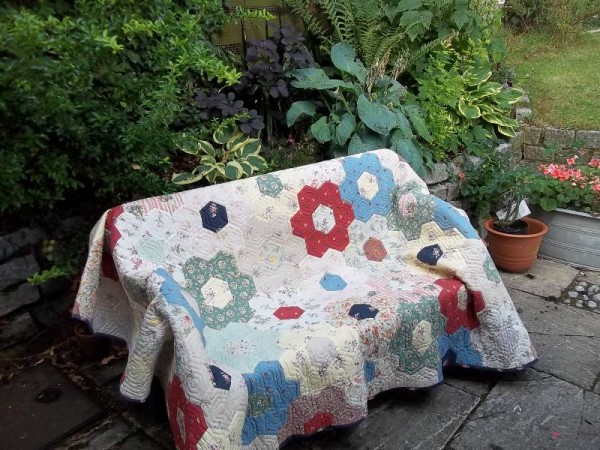
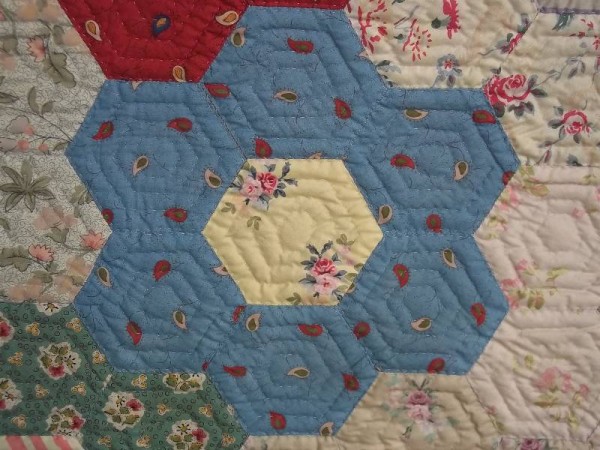
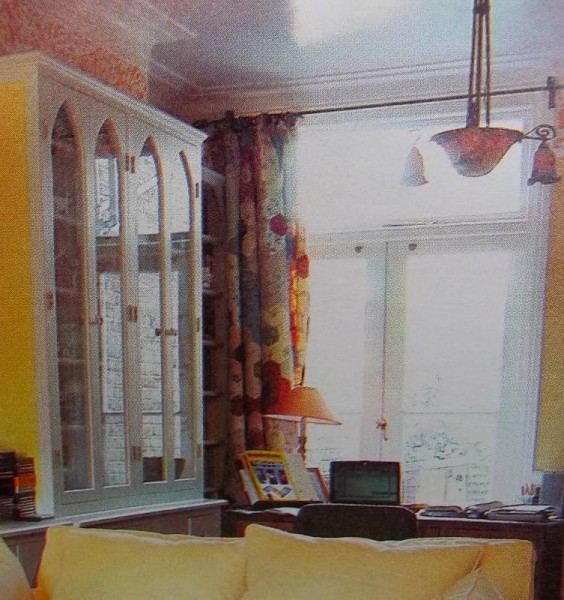
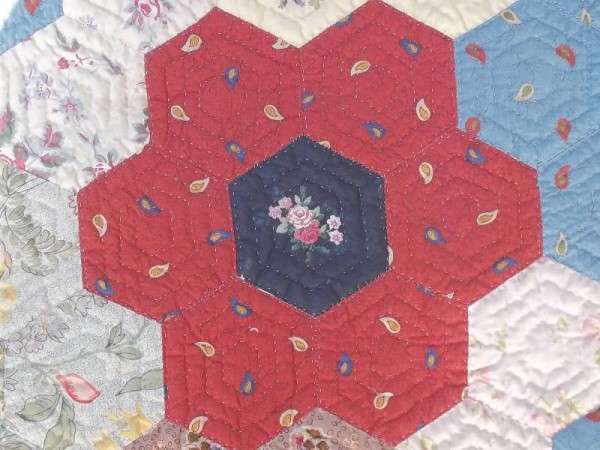
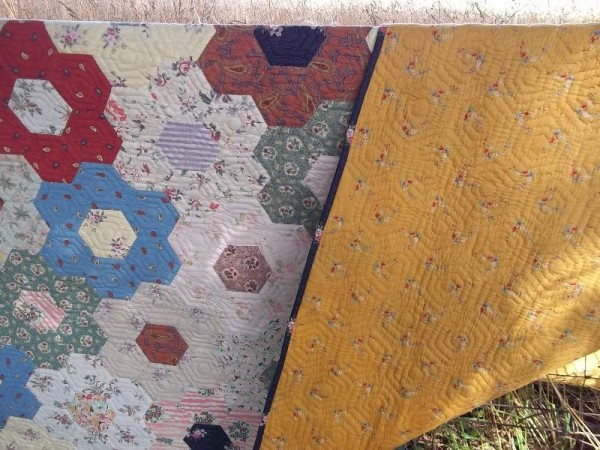
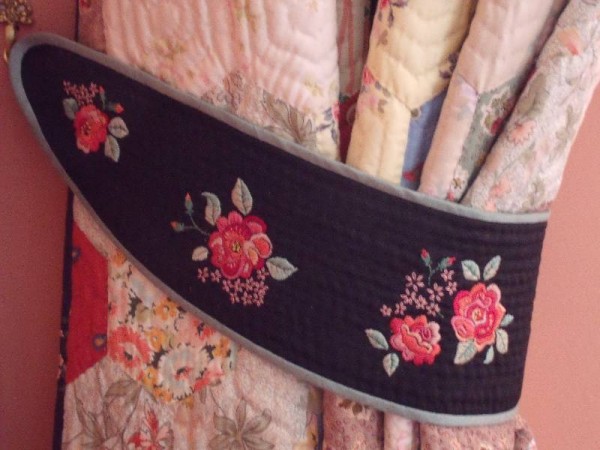
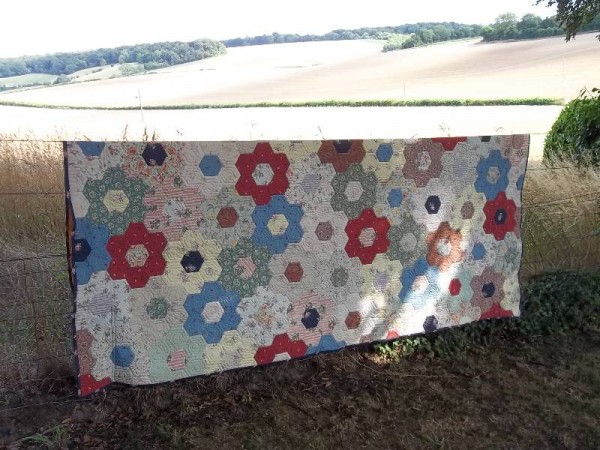
2 Comments
Hello
I discovered your blog via Jane Brocket’s Yarnstorm and it reaffirms my faith in the ” blogging” world .
Yours is a real delight and like Jane’s is so well written- which is all too rare!
I live in Australia and your account of life in England is charming.
I too quilt and embroider in my spare time( which is not plentiful) and have senna Grandmother’s flower garden for my daughter. I too love paper piecing and it has fortified me through many a school debate and netball game.
Eleanor’s quilt is on 30’s reproduction prints.
I could send you a photo.
Kind regards
Kathryn
Many thanks for your kind comments and I’m very glad that you enjoy the blog.
I looked for your quilt but was unable to find it. Do send me a photo (maryaddison16@g.mail.com) as I would love to see your quilt.